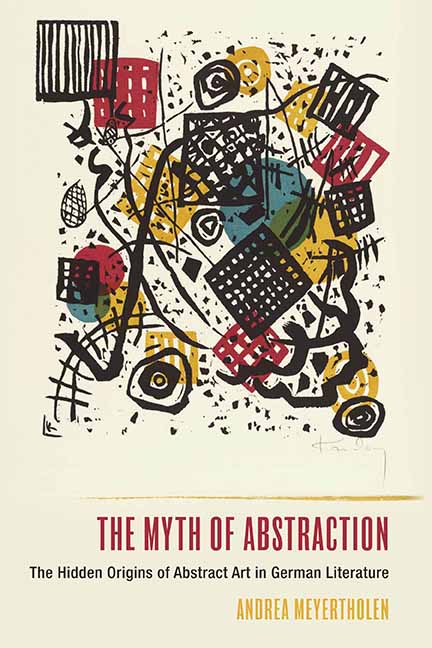Book contents
- Frontmatter
- Dedication
- Contents
- List of Illustrations
- Acknowledgments
- Introduction: The Many Origins of Abstract Art
- 1 Apocalypse Now: Heinrich Von Kleist’s Sublime Deframing of Caspar David Friedrich’s Der Mönch Am Meer (1810)
- 2 The Kleistian Sublime Is Now: Kazimir Malevich, Mark Rothko, Barnett Newman
- 3 The Clouding of Perception: Seeing The (Un)Real Potential for Abstraction in the Poetry and Science of Goethe’s Clouds (1821)
- 4 In the Service of Clouds or Optical Illusion?: Romanticism, Pointillism, and Impressionism
- 5 Driven to Distraction and from Abstraction: The Birth and Death of Abstract Art in Gottfried Keller’s Der Grüne Heinrich (1854/55, 1879/80)
- 6 Inside the Mind and Outside the Margins: The Unruly Lines of Paul Klee, André Masson, and Cy Twombly
- Epilogue: Laocoön and His Sisters: The Future of Literature and Art
- Bibliography
- Index
Introduction: The Many Origins of Abstract Art
Published online by Cambridge University Press: 07 May 2022
- Frontmatter
- Dedication
- Contents
- List of Illustrations
- Acknowledgments
- Introduction: The Many Origins of Abstract Art
- 1 Apocalypse Now: Heinrich Von Kleist’s Sublime Deframing of Caspar David Friedrich’s Der Mönch Am Meer (1810)
- 2 The Kleistian Sublime Is Now: Kazimir Malevich, Mark Rothko, Barnett Newman
- 3 The Clouding of Perception: Seeing The (Un)Real Potential for Abstraction in the Poetry and Science of Goethe’s Clouds (1821)
- 4 In the Service of Clouds or Optical Illusion?: Romanticism, Pointillism, and Impressionism
- 5 Driven to Distraction and from Abstraction: The Birth and Death of Abstract Art in Gottfried Keller’s Der Grüne Heinrich (1854/55, 1879/80)
- 6 Inside the Mind and Outside the Margins: The Unruly Lines of Paul Klee, André Masson, and Cy Twombly
- Epilogue: Laocoön and His Sisters: The Future of Literature and Art
- Bibliography
- Index
Summary
FROM DECEMBER 23, 2012, to April 15, 2013, the Museum of Modern Art (MOMA) in New York City held an exhibition entitled Inventing Abstraction, 1910–1925: How a Radical Idea Changed Modern Art. The landmark retrospective celebrated the centennial of its titular event by bringing together over 350 artworks from museums and collectors across North America and Europe. On display were representatives of German Expressionism, Italian Futurism, Russian Constructivism, French Cubism, American Synchronism, and all manner of artists and artworks eluding neat categorization into an “ism.” Representing a veritable “who's who” of the early twentieth-century art world, the collection did more than commemorate a historical moment. It told a story. In this case, that story was the origin of abstract art as something made viewable, walkable, and digestible to a general public on the walls and in the vitrines of a few gallery rooms. Curated by Leah Dickerman and Masha Chlenova of MOMA's painting and sculpture department, the impressive array of names and images reconstructed a visual chronicle of the development of abstraction as aesthetic pursuit: how it originated as “radical idea,” experienced its historical birth into incarnate form, and subsequently “changed modern art” in the early years of its praxis.
Visitors entering the exhibition were greeted by the biggest name of all, at least for the emergence of abstract art: Wassily Kandinsky (1866– 1944). “Must we not then renounce the object altogether, throw it to the winds and instead lay bare the purely abstract?” asked the words emblazoned over the portal leading into the first installation space. That question was posed by Russian-born artist in 1911. This year—more specifically, December of this year—is key. For it was in December of 1911 that Kandinsky, who had been working in Munich since 1896, published the text in which this question first appeared; this was the aesthetic treatise Über das Geistige in der Kunst: Insbesondere in der Malerei (Concerning the Spiritual in Art: Especially in Painting). It was in December of 1911 that the avant-garde artist circle known as the Blauer Reiter (Blue Rider) staged its inaugural show in Munich.
- Type
- Chapter
- Information
- The Myth of AbstractionThe Hidden Origins of Abstract Art in German Literature, pp. 1 - 21Publisher: Boydell & BrewerPrint publication year: 2021



